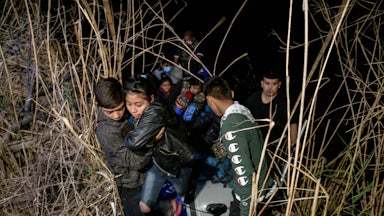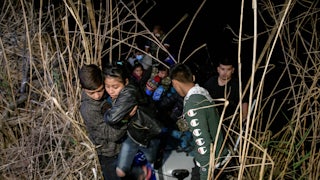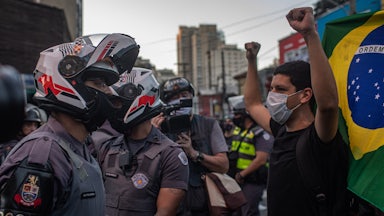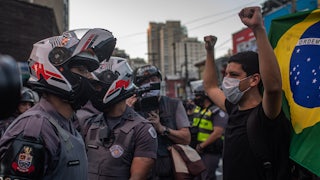Victoria Salazar, a Salvadoran woman who had fled her country and sought refuge in Mexico, was killed by the police in Tulum late last month when an officer knelt on her neck during an arrest. The incident, caught on camera by passersby, immediately evoked comparisons to the 2020 killing of George Floyd in Minneapolis at the hands of Derek Chauvin, who asphyxiated Floyd by kneeling on his neck for over nine minutes, which was also caught on camera.
Salazar was a 37-year-old single mother who had left El Salvador in 2016 in search of a better life for her two daughters, who are now teenagers. Residents of her hometown of Sonsonate experience high rates of violence, and especially violence against women; Salazar herself faced threats from violent gangs. Amid these threats to her safety and a lack of job opportunities, she, like thousands of others, headed north. She reached Tapachula, on Mexico’s southern border with Guatemala, in fall 2017, where she applied for a humanitarian visa.
Victoria Salazar left her country to seek safety but found death instead. Last March, Salazar was arrested by police, who had received calls that she was publicly intoxicated at a gas station. During the course of that arrest, a female police officer knelt on her neck, refusing to release her despite her cries for help. Two other police officers on the scene watched idly from their police car, while another officer paced back and forth. They ended up carrying her unconscious and soon to be lifeless body into the back of the vehicle.
As in the aftermath of the murder of Floyd, protests followed in Mexico and El Salvador, mostly organized by feminist organizations. “It was not only machismo but also racism that killed Victoria,” activist Monica Fernandez told El Pais. “Can you imagine if she had been white or European? Do they really want us to believe that they would have grabbed her like this and thrown her on the floor like that?”
Fernandez’s criticism could just as easily be applied in the cases of George Floyd, Daunte Wright, or Adam Toledo. Indeed, the similarities between these deaths go beyond the horrifying way that law enforcement officers carried out these extrajudicial killings, and the fact these incidents were filmed. None of these events were isolated occurrences. All of those killed were victims of the transnational tradition of racist and xenophobic policing and violence wrought by law enforcement against people of color and migrants, which has been built here at home in the United States and shipped abroad.
In Mexico and Central America, this tradition is often underwritten and funded by the U.S. government. The U.S. exports its guns and policing strategies to countries like Mexico and El Salvador, and in recent years it has outsourced its immigration enforcement there, too.
As a statement from the Committee in Solidarity with the People of El Salvador, or CISPES, in response to Salazar’s death reads, “State violence perpetrated against Black people in the United States is intrinsically connected to the state violence Central Americans, particularly indigenous and Afro-Central Americans, are subjected to in their countries of origin and while migrating. The transnational nature of this violence requires a transnational response.”
Yet despite promises that the new administration would take a different approach from its predecessor’s, the Biden administration announced last week that it had entered into an agreement with the governments of Mexico, Guatemala, and Honduras, in which those nations would mobilize an additional surge of police and troops in order to “make it more difficult to make the journey” to the U.S. border, “and make crossing the border more difficult,” as White House press secretary Jen Psaki explained to reporters.
As Psaki outlined, the current plan will include stationing 10,000 police and troops on Mexico’s southern border, down from over 20,000 during the Trump years, and 1,500 similarly-styled personnel on the Guatemala-Honduras border, and adding dozens of new immigration checkpoints in Honduras. According to Psaki, Honduras has also recently deployed 7,000 police and troops to try to stop a migrant caravan headed north.
The plan draws from an old, failed playbook of trying to prevent migration by making it more dangerous and more difficult to cross borders. Far from deterring migration, which has been a constant in human history, these policies tend to lead to more violence and abuses against migrants as they are forced to find more remote routes and rely on smugglers to move across borders. On the U.S. southern border, this strategy has led to at least 7,000 migrant deaths since 1994, though a complete accounting is impossible.
“The idea that … deploying a military force or police force at border areas is the solution is a super-old route that the U.S. has tried over and over again, and in the process committed serious violations,” said Oscar Chacón, executive director of Alianza Americas, a network of migrant-led organizations.
It isn’t precisely clear how much of this surge is a result of the Biden administration’s discussions with the governments of these countries, and how many additional personnel might have been put to the task without the White House’s involvement. Government officials from both Honduras and Guatemala denied that any agreement was signed in advance of last week’s announcement. According to Yuriria Salvador, a coordinator with the Fray Matías de Córdova Human Rights Center in Tapachula, Mexico had already planned to send more border patrol agents and National Guard to its southern border, under the pretense of stopping human trafficking.
Regardless of how the surges have come about, Salvador tells The New Republic that Biden’s announcement indicates that international cooperation on migration will continue to focus on police crackdowns and containment, rather than the amelioration of the problems that send migrants on their mission to seek refuge from the constant threat of deadly danger. The Biden administration is not approaching the increase in migration from a “rights-based perspective,” Salvador said, meaning that migrants are often not even given the option to apply for asylum before being sent back to their home countries.
Biden’s moves evoke a sense of déjà vu to the Obama administration. Faced with an increase in unaccompanied children arriving at the U.S. border in 2014, the Obama White House unveiled its Southern Border Plan, which took prevention-through-deterrence to Mexico’s southern borders with Guatemala in earnest for the first time. Between 2014 and 2019, the U.S. sent approximately $200 million to Mexico to fortify its borders and surge the number of immigration officers, immigration checkpoints, and immigrant detention centers across the country, with the goal of increasing apprehensions and deportations of migrants throughout the country. That funding came in large part from the billions of dollars that have been apportioned to Mexico to fight the failed war on drugs, which has wrought havoc across the region and become a major push-factor for migration.
As vice president, Biden led Obama’s foreign policy toward Central America via the so-called Alliance for Prosperity, asking Congress to appropriate $1 billion to the region in 2015. That amount was subsequently whittled down in appropriations; the vast majority of the remainder was allocated to fund police and military aid. The U.S. spent a total of $3.6 billion in security and development aid to Central America between 2016 and 2020, especially in Guatemala, El Salvador, and Honduras.
As president, Biden has pledged some $4 billion to the region to address the “root causes” of migration. Following his former boss’s lead, he appointed his own vice president, Kamala Harris, to lead the effort. Some of that aid, as it was during the Obama administration, will be restricted if the receiving countries are determined not to be upholding certain conditions, like tackling corruption. As some will recall, Trump cut off aid entirely to those countries in 2019 when he deemed their efforts to prevent migration to be insufficient.
The approach Biden has announced seems to forget that the Trump administration happened, and fails to account for both his predecessor’s bullying of Central American countries and outright refusal to recognize the international right to asylum. Moreover, it glosses over any lessons that might be gleaned from that era about how bad things got. This was never more in evidence than it was last Friday, after the White House’s announcement that the cap on refugees admitted to the U.S. would remain at the historically low 15,000 people set by Trump—rather than rising to 65,000, in fulfillment of Biden’s campaign promise—was met by a furious outcry. Though Biden quickly bowed to the intense public pressure, the wrongheadedness of maintaining the cap in the first place, along with the sending of police and troops to Central American border regions, suggest that Biden’s approach to immigration policy might be to try to split the difference between the Obama and Trump eras, rather than learning from the mistakes of both his former boss and his most recent predecessor in an effort to, as Biden himself might put it, “build back better.”
As Samantha Pineda, program director at CISPES, told The New Republic, Biden’s approach is “practically condoning violence against migrants, because increasing policing presence in Central American borders implies that violence is going to be used against migrants and refugees to prevent them from coming up to the U.S. southern border. It also implies that people are going to be denied their right to asylum.” Empowering law enforcement on the borders puts women at particular risk, she noted.
Many, including Victoria Salazar, are fleeing domestic violence; many more endure sexual violence and rape during their journeys, at the hands of organized crime as well as law enforcement. Women in Mexico and Central America on the whole suffer alarming rates of femicide. But beyond that, the misogynistic and patriarchal culture that is so deeply embedded in the structure of policing itself can’t be disconnected from the physical abuses police carry out whether in the U.S. or across the region.
It’s not clear if Salazar intended to ultimately seek asylum in the U.S. As the already dangerous journey through Mexico became increasingly difficult, due to the Southern Border Plan, some asylum-seekers opted to apply for protection in Mexico, where visa applications skyrocketed. That trend only increased under the Trump administration. Further militarization of Mexico’s southern border will likely exacerbate an already dangerous situation by ensuring a greater number of encounters between migrants fleeing danger at home and well-armed police battalions aiming to “deter” their migration.
Though it’s several steps short of forcing places like Guatemala and Honduras to become “safe third countries,” as the Trump administration tried to do, or continuing the Remain in Mexico plan, maintaining a police presence on these borders is part and parcel of the same failed enforcement logic that has long guided U.S. immigration policy, one that views migrant lives as inconvenient and disposable. As Pineda put it, “Policing [in the U.S.] and criminalization of migrants and refugees is leading to the same results, which is death and repression.”
If policing within our own borders abets the collateral damage it inflicts on poor and Black communities, so too do plans like Biden’s to outsource immigration deterrence to police and migration officials who are well known for corruption and abuses and who report to governments that are similarly well known for their own corruption and abuses. By having someone else do its dirty work, the U.S. can turn a blind eye to those abuses and keep its hands clean.
But as Alianza Americas’ Chacón puts it, anyone who has spent even “half an hour” studying the history of police and armed forces in countries like Honduras, Guatemala, and Mexico understands that these institutions have themselves “been the perpetrators of systematic human rights violations” and thus contribute to the very dire conditions that cause people to migrate in the first place.
In Honduras, current President Juan Orlando Hernández, whose reelection was illegal and likely fraudulent, has been implicated in a number of credible drug trafficking allegations, and his brother was recently sentenced to prison by a U.S. federal court for drug trafficking. And conditions in Honduras have worsened significantly since a 2009 coup ousted its democratically elected leader, Manuel Zelaya, a move Hillary Clinton’s state department at best ignored. Today, the U.S. government continues to support Hernández’s government, save for occasional slaps on the wrist, despite the fact that state-sanctioned violence is a major push factor for migration.
The irony of it all is that the U.S. is shaping the immigration and security policies of smaller, less powerful countries fighting the scourge of gang violence and collusion, when its own law enforcement kills civilians by the thousand every year. Yet somehow, amid all the violence its law enforcement officers perpetrate, the U.S. has seen itself fit to export its policing and border control strategies.
In the days after the murder of Daunte Wright in Brooklyn Center, Minnesota, Charles Blow wrote in a New York Times column, “A society that treats this much Black death at the hands of the state as collateral damage in a just war on crime has no decorum to project.” We can take his words a step further when thinking of the ways that the U.S., despite all the abuses its law enforcement perpetuates, insists on projecting that same violence abroad.








